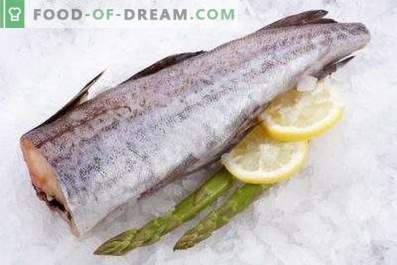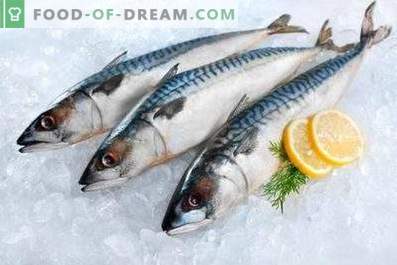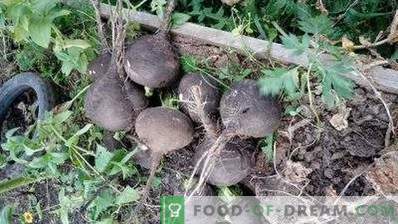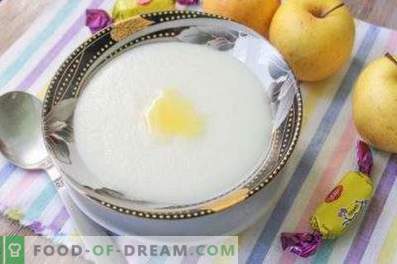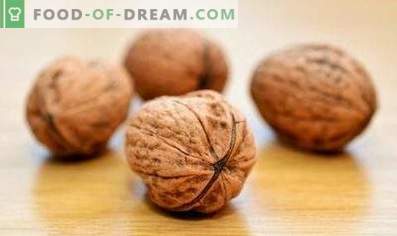
A hake, or hake, is a bottom fish belonging to the family Merlucciidae. Representatives of this genus are widely distributed in the waters of the continental plume of the Pacific and Atlantic oceans. All species of hake are valuable objects of fishing. The total annual catch of this fish exceeds 1.5 million tons.
Fresh hake meat is highly valued in cooking due to its low fat content and low bone count. Headless and gutted carcasses of this fish are fried, stewed, boiled and baked in ovens. In addition, on the basis of the hake fillet prepare soups, cutlets, salads and baking stuffing. Part of the meat goes to the manufacture of fish meal.
Appearance
Hake has a beaded body covered with fine and small cycloid scales. The back of the representatives of this genus is dark gray, the sides are silvery, the belly is almost white. Hallows fins (caudal, two dorsal, anal and pectoral) are painted black. On the body of the fish there is an almost unbroken dark gray lateral line.
The hake has a large head (up to 1/3 of the body length) with an elongated and flattened snout. The iris of the fish eye is golden, the pupil is black. The lower jaw of the hake is slightly longer than the top. Barb on the chin of a fish is missing. Sharp and well developed teeth on both jaws are arranged in two rows.
Hake is a relatively large fish. The body length of an adult individual varies in the range of 30-130 cm. The weight of representatives of this genus can reach 5, 5 kg.
Nutritional Value
A 100 g fillet of hake contains:
- 16, 574 g of proteins;
- 2, 155 g of fat;
- 79, 849 g of water;
- 1, 114 g of ash;
- 69, 412 mg of cholesterol.
Merluse is rich in essential and non-essential amino acids. In addition, the product contains fatty acids (0, 409 g of omega-3 and 0, 038 g of omega-6 per 100 g of the edible part of the product).
Vitamins in fish
100 g of hake meat contains the following vitamins:
- retinol equivalent, A - 9, 991 µg;
- beta-carotene - 0, 009 mg;
- thiamine, B1 - 0, 123 mg;
- riboflavin, B2 - 0, 084 mg;
- pyridoxine, B6 - 0, 092 mg;
- folic acid, B9 - 11, 067 μg;
- cobalamin, B12 - 2, 314 mcg;
- ascorbic acid, C - 0, 438 mg;
- tocopherol equivalent, E - 0, 394 mg;
- niacin, PP - 4, 296 mg.
Along with this, rare vitamins such as calciferol (1, 434 mcg per 100 g) and biotin (0, 994 mcg per 100 g) are present in the hake.
Useful items
Macronutrients in 100 g hake:
- potassium - 334, 572 mg;
- calcium - 29, 016 mg;
- magnesium - 34, 519 mg;
- sodium - 76.014 mg;
- sulfur - 199, 116 mg;
- phosphorus - 241, 518 mg;
- chlorine - 166, 773 mg.
Trace elements in 100 g of hake:
- iron - 0,697 mg;
- iodine - 161, 737 mkg;
- cobalt - 19, 043 mkg;
- manganese - 0, 121 mg;
- copper - 136, 122 μg;
- molybdenum - 4, 064 mcg;
- nickel - 6, 224 mcg;
- fluorine - 701, 002 μg;
- chrome - 56, 096 mkg;
- zinc - 0, 878 mg.
Hake calories
100 g of raw hay fillet contains 86, 002 kcal. The energy value of a similar portion of boiled hake meat is 84, 203 kcal, roasted - 149, 437 kcal, baked - 92, 316 kcal, stewed - 89, 077 kcal. Calorie hake patties - 196, 407 kcal per 100 g
Useful properties of the hake
- Hack is a low-fat fish. Therefore, the dishes from it are useful for people who want to lose weight (the exception is a hake, fried in a large amount of oil).
- The product contains a large amount of easily digestible proteins.
- The hake contains a whole range of substances that help to reduce the concentration of sugar in the blood. Therefore, snacks and dishes from this fish are often included in the diet menu for diabetics.
- Vitamins and minerals that this product is rich in help to normalize the functioning of the thyroid gland.
- Regular consumption of hake helps to improve the functioning of the digestive system organs.
- Fish contains substances that accelerate the elimination of toxins and poisons from the human body.
- Vitamins of group B, contained in meat of hake, normalize the work of the nervous system, reduce the destructive effect of stress on the body, improve sleep. In addition, they activate metabolic processes and prevent the occurrence of exchange failures.
- Hake is very good for the eyes. The use of this fish helps to increase visual acuity, to prevent the development of disturbances in the work of the visual apparatus with increased loads.
- Vitamins and minerals entering the body through the use of hake help to strengthen bone tissue and prevent the occurrence of dental diseases and diseases of the musculoskeletal system.
- Vitamins A, E and other antioxidants contained in this product neutralize the harmful effects of free radicals, slow down the aging of tissues, minimize the risk of developing cancer.
- Hack helps to normalize blood pressure in hypertension, strengthen the walls of blood vessels and give them additional elasticity, improve the work of the heart muscle. People who include it in the diet at least twice a week, minimize the risk of developing heart disease.
- With regular consumption of hake, the condition of hair, nails, skin and mucous membranes is significantly improved.
- The combination of minerals and vitamins present in the hake helps to speed up the recovery of the body after increased mental and physical exertion, prolonged illness, surgery and injuries.
- Nutrients with which hake is rich can increase the body's natural resistance to infectious and catarrhal diseases.
- Vitamin A and folic acid, contained in the fillets of this fish, stimulate brain activity.
- It has been proven that regular consumption of hay dishes helps improve reproductive function (normalize the composition of the ejaculate and increase the activity of sperm in men, increase the likelihood of conception in women, reduce the risk of developing diseases of the genitourinary system in both sexes).
Contraindications and harm
- Meat of hake can provoke the development of allergic reactions in the form of skin rash, itching, urticaria, angioedema or anaphylactic shock. That is why people who have previously been identified individual intolerance to fish or other seafood, should completely eliminate hake from the diet.
- Abuse of fried hake can lead to obesity.
- Hake fillet is contraindicated in case of gastrointestinal diseases developing on the background of increased acidity of gastric juice.
- Frequent consumption of hake can cause chronic constipation.
- Pediatricians advise not to give hack dishes to children under 4 years old.
- Any fish (including hake) may be infected with parasites. Therefore, before eating it should be subjected to thorough heat treatment.
